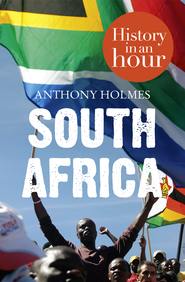
Полная версия:
South Africa: History in an Hour

SOUTH AFRICA
History in an Hour
Anthony Holmes
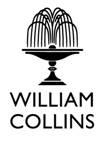
Copyright
William Collins
An imprint of HarperCollinsPublishers Ltd 1 London Bridge Street London SE1 9GF
www.harpercollins.co.uk
Visit the History in an Hour website:
www.historyinanhour.com
First published by HarperPress in 2012
Copyright © Anthony Holmes 2012
Series editor: Rupert Colley
IN AN HOUR ® is a registered trade mark of HarperCollins Publishers Limited
Cover image © Obed Zilwa / AP / Press Association Images
All rights reserved
The moral right of the author is asserted All rights reserved. This book is sold subject to the condition that it shall not, by way of trade or otherwise, be lent, re-sold, hired out or otherwise circulated without the publisher’s prior consent. No part of this text may be reproduced, transmitted, downloaded, reverse engineered, or stored in or introduced into any information storage and retrieval system, in any form or by any means whether electronic or mechanical, now known or hereinafter invented, without the express written permission of HarperCollins ebooks.
Ebook Edition © MAY 2013 ISBN: 9780007485208
Version: 2016-01-13
About History in an Hour
History in an Hour is a series of ebooks to help the reader learn the basic facts of a given subject area. Everything you need to know is presented in a straightforward narrative and in chronological order. No embedded links to divert your attention, nor a daunting book of 600 pages with a 35-page introduction. Just straight in, to the point, sixty minutes, done. Then, having absorbed the basics, you may feel inspired to explore further. Give yourself sixty minutes and see what you can learn . . .
To find out more visit www.historyinanhour.com
Contents
Cover
Title Page
Copyright
About History in an Hour
Introduction
White Settlers Arrive in South Africa
‘The Great Trek’ from British Rule
Self Government for the Cape Colony
The War between the Zulus and the White Colonists
The Boers Versus the British
The National Party of South Africa
The Struggle for Equality
Apartheid
Black Resistance and the Sharpeville Massacre
International Pressure and Internal Armed Resistance
Right-Wing Extremism and the AWP
Global Condemnation of Apartheid
The Tri-Cameral Parliament
The Struggle Escalates
Towards a Better Future for All
The New South African Constitution
Appendix 1: Key Players
Appendix 2: Timeline of South Africa
Got Another Hour?
About the Publisher
Introduction
On 10 April 1993 South Africans held their collective breath.
In the midst of discussions on the transition from a white oppressive regime to a multiracial democracy, Chris Hani – the black leader of the South African Communist Party and Chief of Staff of the armed wing of the African National Congress (ANC) – was murdered. White ultra-conservatives gunned him down in front of his family, as he stepped out of his car.
This assassination was part of a plot to destabilize the negotiations to end apartheid – a system of racial segregation in force from 1948–1994 in South Africa. His neighbour, a white woman, rushed to call the police and the perpetrator, Janusz Waluš, was arrested. His accomplice Clive Derby-Lewis, a Member of Parliament in the Conservative Party and right-wing extremist, was subsequently also arrested. Both men were found guilty of murder.
The country was poised on a knife-edge. Black people were incensed and enraged at the assassination. White people were shocked by the brutality of the crime and terrified of the expected black backlash. It took a man of incredible wisdom, courage and statesmanship to make a speech to calm things down. A man who had been recently released after being jailed for twenty-seven years by the same oppressive, right-wing regime. A man who had not yet ascended to any office of State but who was generally acknowledged to be the de facto leader of the country.
Nelson Rolihlahla Dalibhunga Mandela broadcast the following message to his people, to his country; a voice that had been silenced for so long, but which was to become one of the world’s best known voices:
Tonight I am reaching out to every single South African, black and white, from the very depths of my being. A white man, full of prejudice and hate, came to our country and committed a deed so foul that our whole nation now teeters on the brink of disaster. A white woman, of Afrikaner origin, risked her life so that we may know, and bring to justice, this assassin. The cold-blooded murder of Chris Hani has sent shock waves throughout the country and the world . . . Now is the time for all South Africans to stand together against those who, from any quarter, wish to destroy what Chris Hani gave his life for – the freedom of all of us.
Although some riots did follow Chris Hani’s murder, the two sides of the negotiation were galvanized into action. The process was not allowed to drag on and they rapidly came to the agreement that democratic elections should take place on 27 April 1994, just over a year after Hani’s assassination. The short speech given by Nelson Mandela saved South Africa from descending into chaos.
What tortuous path led South Africa to this dramatic moment in its history? To appreciate the ‘politics of colour’ that encompassed the lives of Nelson Mandela, Walter Sisulu, Oliver Tambo, John Vorster, P. W. Botha, F. W. de Klerk and millions of South Africans of all races, religions, professions, and beliefs in the second half of the twentieth century one must go back through the history of South Africa.
And this, in an hour, is South Africa
White Settlers Arrive in South Africa
The conflict between black Africans and white people in South Africa finds its origin in the seventeenth century. White men from the Netherlands established a permanent harbour at the Cape of Good Hope to replenish food and water, and conduct repairs for the trading fleet of the Dutch East India Company (VOC). Jan van Riebeck arrived in the Cape in 1652 with a party of eighty men with instructions from the Company to build a fort and develop a vegetable garden to provision the ships on their voyages to and from the east.

1652 Jan van Riebeck arrives at the Cape
Painting by Charles Davidson Bell
The history of South Africa from 1652 onwards was written by the white historians. The history from the perspective of the black people was handed down orally. As is the way with history, each party paints a picture favourable to themselves, and each naturally accepts their version as ‘the truth’.
The first tribe encountered by the Dutch settlers were the cattle herders called the Khoikhoi. The initial contact with the Khoikhoi was based on barter; however the groups had differing philosophies of ownership, especially when it came to livestock. This led to animosity and accusations of theft from the side of the white farmers, whereas the Khoikhoi subscribed to the concept that cattle did not ‘belong’ to anyone.
The Slave Period
After serving their five-year contracts with the VOC, nine men were released from their contractual obligations and given their own land to farm. They were called vryburgers (free burghers). In 1658 the first slaves were brought to South Africa from other parts of Africa, and later Madagascar, India, and East Asia. Most were labourers and servants but many of them were skilled carpenters and bricklayers. The VOC owned most of the slaves in South Africa’s Cape colony. They were confined to living quarters in a huge slave lodge (later converted into the old Supreme Court and more recently the South African Cultural History Museum) while other slaves were owned and housed by the vryburgers.
Four years later, when van Riebeck returned to Holland in 1662, there were about 250 settlers in what was clearly now a permanent colony. Further expansion saw independent farmers emigrate to South Africa and in the early 1700s the so-called ‘trekboers’ or pioneer farmers started to push outwards towards the north and east. The geographic location of the black African tribes at the time determined that the Xhosa would be the first black tribe to encounter the white farmers. With the Xhosa continuing their migration westwards along the southern coast and the white farmers searching for new opportunities to the east, confrontation was inevitable.
The Wars between the Xhosa and the White Settlers
The conflicts between the Xhosa people and the white farmers were called ‘The Kaffir Wars’. The term ‘Kaffir’ originated from the Arabic-Islamic term Kafir meaning ‘a non-believer’. The word is considered racially offensive in the present day. The use of the ‘K’-word has been actionable under South African law since 1976. There were nine conflicts between the Xhosas and the white settlers, now known as the Xhosa Wars.
The first Xhosa War is recorded as having begun in 1779. Wars followed in 1789, 1799, and 1811, but protracted skirmishes were virtually continuous. Outcomes were indecisive. The sides were evenly matched. The white settlers were heavily outnumbered but they had the better weaponry.
Meanwhile in Europe the newly established Republic of France conquered the Netherlands in 1795. The Netherlands was re-named the Batavian Republic and Prince William of Orange fled to England. Once there the prince asked England to prevent France taking possession of the Dutch colonies. At the behest of Prince William, Britain occupied the Cape colony in 1795, later occupying it permanently from 1806 and ruling it as a crown colony.
The British were in a better position to bring force to bear in South Africa. They commanded military resources in India as well as Britain and were determined to put an end to the frontier problem. In 1820 an emigration scheme brought 5,000 white British settlers to the frontier districts. This move only served to increase the competition for land between the racial groups.
The remaining wars of the nineteenth century were devastating for the Xhosa. Warriors, armed only with spears and clubs, fought against guns. The loss of life was great. The British maintained a military force to protect the white colonists, but the farmers were still harassed and subject to theft of their livestock. Land was seized progressively by the settlers in each successive war and the pressures on the Xhosa intensified with each defeat. The Xhosa, divided into a number of chieftaincies, was unable to coalesce into a cohesive fighting force.
In a tragic turn of events in 1857, the Xhosa were persuaded by their witch doctors that they would succeed against the white man if they destroyed all their own cattle. This disastrous self-inflicted catastrophe resulted in 400,000 head of cattle being killed and 40,000 Xhosa dying of starvation, which so weakened the Xhosa that military action was not pursued for a generation. In 1877 further pressure from the white colonists brought a final and hopeless military response from the Xhosa. The Cape Colony annexed all remaining Xhosa lands effectively ending the independence of the Xhosa.
The Coloured (Mixed Race) People
In the Cape Colony itself, the remnants of Khoikhoi that had not moved away mingled with the slaves from elsewhere in Africa. They interbred with white people and with a new category of slaves from the East, particularly Malaysia, producing the mixed race group which was later given the designation of ‘Coloured’. The slaves from East Asia brought Islam into the Calvinistic settler establishment. The vryburgers employed the slaves to help with domestic chores and the cultivation of wine, vegetables, and wheat. A few slaves were freed on their owners’ death and earned a living by catching fish and selling vegetables.
It would not be until 1833, following the Slavery Abolition Act in Britain that a law was passed in South Africa freeing all slaves – thirty-two years prior to the ending of slavery in the US. The law allowed for a four-year apprenticeship after which slaves were free to leave their owners but which left many slave owners bankrupt because there was no one left to perform the labour.
‘The Great Trek’ from British Rule
The Dutch-speaking colonists did not take kindly to British rule. They blamed the new administration for not providing sufficient protection from the Xhosa, abolishing slavery, and espousing a new liberalism towards black Africans. 1836 witnessed the first of several migrations to the north and north-east. Approximately 14,000 people, including servants and employees, embarked on what collectively became known as the ‘Great Trek’, the mass migration of Dutch-speaking colonists searching for a promised land where they could establish a free and independent state. The lifestyle of the ‘trekboers’ (nomadic farmers) enabled them to pack their possessions into ox-drawn wagons and leave the colony forever.
The families who set out from the eastern frontier towns represented a small fraction of the Dutch-speaking inhabitants of the colony. Called Dutch Boers by the British, they called themselves as Afrikaners. Their pioneering courage is remembered as the most important aspect of Afrikaner folk memory.
Represented in later days as a peaceful and God-fearing journey into the unknown, the Great Trek caused tremendous upheaval in the lives of the indigenous people. Messengers made their way to the chiefs of the Sotho clans to report that the white men were coming in their hundreds.
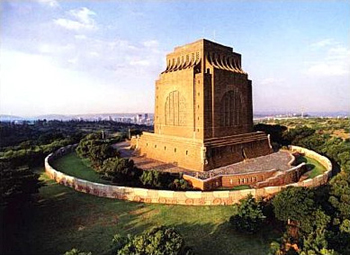
The Voortrekker Monument
The Voortrekkers (pioneers) had to face the uninviting prospect of the barren Kalahari Desert, the tsetse fly belt, and the realm of the deadly malarial mosquito. Yet they trekked onwards, intent on gaining access to ports beyond the sphere of British control, at Delagoa Bay, Inhambane, and Sofala. In order for their new settlement to be viable, it was crucial that they establish independent trading links with Europe.
The British resented any intrusion by other European powers in their colony’s affairs. Whenever ‘foreign’ interference was detected, the British used the expedient of annexing the territory concerned. In the 1840s, the Voortrekkers of the Republic of Natalia endeavoured to open contacts with the Netherlands, so the British annexed Natal, but recognized independent Boer republics in Transvaal and the Orange Free State. In the 1880s Germany annexed South West Africa (modern Namibia) resulting in the British pre-emptive action of annexing Bechuanaland (modern Botswana).
Self Government for the Cape Colony
In 1853, the British Government conferred a representative legislature on the Cape Colony which made a timid move towards political equality among the races. The non-racial franchise was based on economic qualifications, but in practice it excluded the vast majority of black and coloured people. Nevertheless, the promise of full political inclusion existed. In 1872 the Cape Colony was granted self government. Over the following twenty years the expansion of the colony resulted in the inclusion of great numbers of native voters. The government progressively raised the franchise hurdle. Communal land ownership was excluded as a qualification and proof of the ability to write was introduced as a requirement.
The Discovery of Diamonds
An exciting new element entered the economic and political balance: diamonds were discovered in 1867 when two children found a shiny pebble near the Orange River, leading to the development of the town of Kimberley. As a consequence, interested parties now realized that the land opened up by the migration of the Boers had more than just nuisance value. There was wealth for the taking.
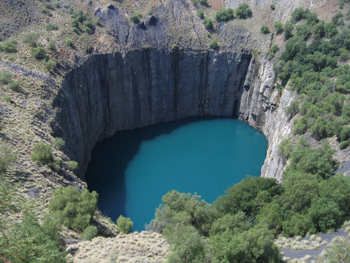
The ‘Big Hole’ at Kimberley
I, Bothar
In a totally predictable move the area around Kimberley, known as Griqualand, was incorporated into the Cape Colony in 1880. Thousands of prospectors and diamond diggers were attracted from all over the world to Kimberley. Like so many termites, they attacked the outcrop of diamond-bearing ground with such voracity that it was transformed from a hill into the famous ‘Big Hole’.
The War between the Zulus and the White Colonists
While Kimberley was exploiting its newly discovered wealth, the Colony of Natal was developing along somewhat different lines. Here, the fearsome Zulu nation had grown to menacing proportions. Under African law, black refugees fleeing from Zulu power were given sanctuary in buffer reserves. Outside those reserves, British law held sway. Black Africans in the reserves were under the rule of the chiefs.
The late-nineteenth century was a period of further colonial expansion, a pressure which the Zulus tried to withstand. At the beginning of 1879 a force of 1,800 British troops equipped with modern weapons invaded Zululand. Under King Cetshwayo, the Zulu ‘impi’ (army) of 20,000 warriors, mostly carrying spears and clubs delivered a resounding defeat on the unprepared British at Isandhlwana. Over 1,300 British soldiers were killed.
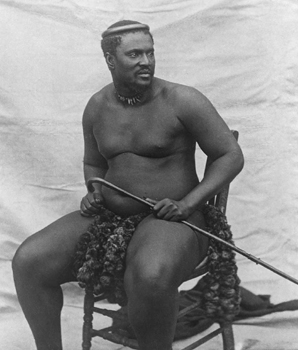
Cetshwayo, King of the Zulus
The British defeat in what was termed the First Anglo-Zulu War resulted in a much stronger force invading Zululand the following year; and this time the Zulu King Cetshwayo was defeated. One month later he was captured and exiled to Cape Town. In 1882, Cetshwayo visited England where he was granted an audience with Queen Victoria. He was promised reinstatement as king, but in 1883, upon his return to Zululand, Cetshwayo was appointed ‘king’ over a buffer reserve considerably smaller than his original kingdom. Cetshwayo died in February 1884, possibly poisoned.
Natal had the ideal climate for the cultivation of sugar cane, a labour-intensive activity. Indentured labourers were imported from India, many of whom remained in the country at the end of their contracts. They became the forebears of today’s significant and influential Indian population, which remains mainly resident in the coastal area of Natal.
The Boers Versus the British
Discovery and exploitation of the alluvial gold deposits of Barberton and Pilgrims Rest attracted hordes of prospectors. In 1877 the British adopted their usual tactic and promulgated the annexation of the territory of the self-proclaimed Boer republic. On 20 December 1880, Lieutenant Colonel Anstruther tried to enforce the annexation by marching elements of his regiment from Lydenburg to Pretoria with the regiment’s band leading the column. At Bronkhorstspruit the force was stopped by Boers, who requested the British to turn back. Armstrong refused. The British column was devastated by rifle fire from the surrounding Boer ambush. The British High Commissioner for South East Africa, Major-General Sir George Pomeroy Colley, instead of waiting for reinforcements, assembled the available troops and rushed forward to relieve the British garrisons in the Transvaal.
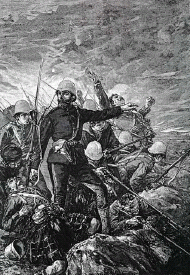
Sir George Colley at Laing’s Nek
Colley gathered his force at Newcastle in Natal. His ultimatum to the Boers was rejected and Colley advanced towards the Transvaal border. The British made camp over 6 km short of Laing’s Nek, a ridge that was occupied by a Boer force. On the morning of 28 January 1881 Colley moved out with his troops. The British infantry of the time wore red jackets, blue trousers with red piping, and white pith helmets. The Boers on the other hand were a citizen militia. They had no uniforms but they were expert marksmen. The British soldiers stood out like ready-made targets on the hilly grassland of the Natal-Transvaal border region.
The 58th Regiment was led up the hillside by Lieutenant Baillie carrying the Regimental Colour and Lieutenant Hill carrying the Queen’s Colour. Baillie was mortally wounded while Hill won the Victoria Cross for bringing casualties down from the hillside.
In an endeavour to regain the initiative Colley led five hundred men to the summit of the flat-topped Majuba Hill (Hill of Doves) overlooking Laing’s Nek. Colley, apparently believing the hill was unassailable, made no provision for its defence. On the orders of the Boer commander 200 agile young men climbed Majuba Hill and with well-aimed skill devastated the unprotected British troops. Colley was killed by a Boer bullet in the ensuing action.
The British expeditionary force of 1,200 soldiers had been repulsed by the Boer forces whose numbers exceeded 3,000 and whose field tactics were better suited to the terrain. This short conflict became known as the First Boer War.
The Gold Rush
In March 1886 George Harrison, an Australian miner, literally stumbled across a rocky outcrop of a gold-bearing reef in the Transvaal. He staked his claim with the government of the Zuid Afrikaanse Republiek (ZAR). It was the greatest gold strike ever recorded. In an ironic twist of fate, Harrison is believed to have sold his claim for £10 after which he left the area and was not heard from again.
Soon the number of, mainly British, foreigners outnumbered the Boers, and by 1899 Britain was demanding that all foreigners resident in the Transvaal be granted the same political rights as Boers. In response, the President of the ZAR demanded that Britain withdraw its troops from the borders of the Transvaal within forty-eight hours failing which the Transvaal and Orange Free State Republics of South Africa would declare war on Britain. In London the news was greeted with laughter and contempt for the little upstart colony, ‘If it’s war they want, then war they will get’. And so, the second Anglo–Boer War began.
The Second Boer War (1899–1902)
Ultimately Britain was to gain the upper hand, but not before 75,000 troops and civilians had lost their lives. The final toll is estimated at 22,000 British soldiers, two thirds of whom died from disease; 7,000 Boer fighters; between 20,000 and 28,000 Boer civilians, mainly in concentration camps; and perhaps 20,000 black Africans. The British employed a scorched earth policy, burning farms, poisoning wells and covering fields with salt to deny the Boers the sustenance to continue the conflict.
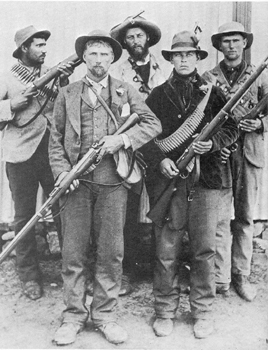
Boer Guerrilla fighters
Boer women and children, and black Africans, were rounded up and placed in concentration camps where the most inhumane conditions were imposed and where many perished. These tactics won the war, but resulted in an enduring hatred of Britain by the Boers. The last of the Boers surrendered in May 1902 and the Treaty of Vereeniging was signed on 31 May 1902.



